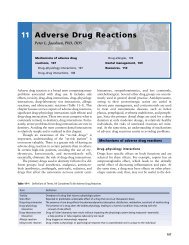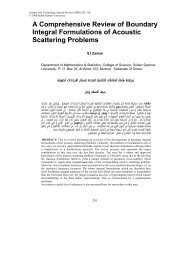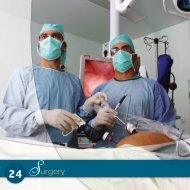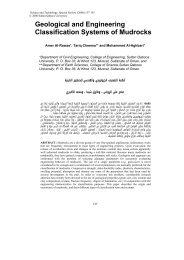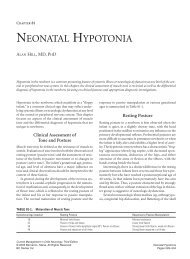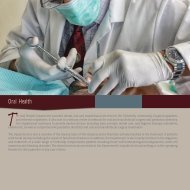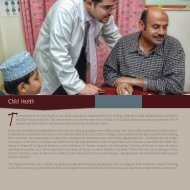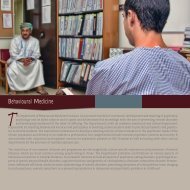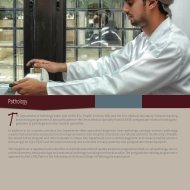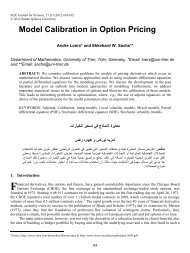Male Reproductive Toxicity - SQU Home
Male Reproductive Toxicity - SQU Home
Male Reproductive Toxicity - SQU Home
Create successful ePaper yourself
Turn your PDF publications into a flip-book with our unique Google optimized e-Paper software.
17. Schrader, S. M., Turner, T. W., Hardin, B. D., Niemeier, R. W., and Burg, J. R., Morphometric analysis ofhuman spermatozoa, J. Androl., 5, 22, 1984.18. Jagoe, J. R., Washbrook, N. P., and Hudson, E. A., Morphometry of spermatozoa using semiautomatic imageanalysis, J. Clin. Pathol., l39, 1347–1352, 1986.19. DeStefano, F., Annest, J. L., Kresnow, M. J., Flock, M. L., and Schrader, S. M., Automated semen analysisin large epidemiologic studies, J. Androl., 8, 24, 1987.20. Turner, T. W., Schrader, S. M., and Simon, S. D., Sperm head morphometry as measured by three differentcomputer systems, J. Androl., 9, 45, 1988.21. Moruzzim J. F., Wyrobek, A. J., Mayall, B. H., and Gledhill, B. L., Quantification classification of humansperm morphology by CASA, Fertil. Steril., 50, 142–152, 1988.22. Schrader, S. M., Ratcliffe, J. M., Turner, T. W., and Hornung, R. W., The use of new field methods of semenanalysis in the study of occupational hazards to reproduction: the example of ethylene dibromide, J. Occup.Med., 29, 963–966, 1987.23. Zukerman, Z., Rodriguez-Rigau, L. J., Weiss, D. B., Chowdhury, A. K., Smith, K. D., and Steinberger, E.,Quantitative analysis of the seminiferous epithelium in human testicular biopsies, and the relation of spermatogenesisto sperm density, Fertil. Steril., 30, 448–455, 1978.24. Whorton, D., Milby, T. H., Krauss, R. M., and Stubbs, H. A., Testicular function in DBCP-exposed pesticideworkers, J. Occup. Med., 21, 161–166, 1979.25. Potashnik, G. and Abeliovich, D., Chromosomal analysis and health status of children conceived to menduring or following dibromochloropropane-induced spermatogenic suppression, Andrologia, 17, 291–296,1985.26. Ratcliffe, J. M., Schrader, S. M., Steenland, K., Clapp, D. E., Turner, T., and Hornung, R. W., Semen qualityin papaya workers with long term exposure to ethylene dibromide, Br. J. Ind. Med., 44, 317–326, 1987.27. Schrader, S. M. and Kanitiz, M. H., Occupational hazards to male reproduction, in State of the Art Reviewsin Occupational Medicine: <strong>Reproductive</strong> Hazards, Gold, E., Schenker, M., and Lasley, B., Eds., Hanley &Belfus, Philadelphia, 1994, pp. 405–414.28. Olshan, A. F. and Mattison, D. R., <strong>Male</strong> Mediated Development <strong>Toxicity</strong>, Plenum Press, New York, 1994.29. Martin, R. H., A detailed method for obtaining preparations of human sperm chromosomes, Cytogenet. CellGenet., 35, 252–256, 1983.30. Martin, R. H., Detection of genetic damage in human sperm, Reprod. Toxicol., 7(Suppl. 1), 47–52, 1993.31. Estop, A. M., Marquez, C., Munne, S., Navarro, J., Cieply, K., Vankirk, V., Martorell, M. R., Benet, J., andTemplado, C., An analysis of human sperm chromosome breakpoints, Am. J. Human Genet., 56, 452–460,1995.32. Evenson, D. P., Flow cytometry of acridine orange-stained sperm is a rapid and practical method formonitoring occupational exposure to genotoxicants, in Monitoring Occupational Genotoxicity, Sorsa, M. andNorppa, H., Eds., Alan R. Liss, New York, 1986, pp. 121–132.33. Evenson, D. P., Jost. L. K., Baer, R. K., Turner, T. W., and Schrader, S. M., Individuality of DNA denaturationpatterns in human sperm as measured by the sperm chromatin structure assay, Reprod. Toxicol., 5(2), 115–125,1991.34. Spano, M. and Evenson, D. P., Flow cytometric studies in reproductive toxicology, in New Horizons inBiological Dosimetry, Gledhill, B. L. and Mauro, F., Eds., Wiley-Liss, New York, 1991, pp. 497–511.35. Holmes, J. M. and Martin, R. H., Aneuploidy detection in human sperm nuclei usisng fluorescence in situhybridization, Human Genet., 91, 20–24, 1993.36. Wyrobek, A. J., Robbins, W. A., Mehraein, Y., Pinkel, D., and Weier, H. U., Detection of sex chromosomalaneuploidies X-X, Y-Y, and X-Y in human sperm using two-chromosome fluorescence in situ hybridization,Am. J. Med. Genet., 53, 1–7, 1994.37. Bischoff, F. Z., Nguyen, D. D., Burt, K. J., and Shaffer, L. G., Estimates of aneuploidy using multicolorfluorescence in situ hybridization on human sperm, Cytogenet. Cell Genet., 66, 237–243, 1994.38. Stachel, B., Dougherty, R. C., Lahl, U., Schlosser, M., and Zeschmar, B., Toxic environmental chemicals inhuman semen: analytical method and case studies, Andrologia, 21, 282–291, 1989.39. Zikarge, A., Cross-Sectional Study of Ethylene Dibromide-Induced Alterations of Seminal Plasma Biochemistryas a Function of Post-Testicular <strong>Toxicity</strong> with Relationships to Some Indices of Semen Analysis andEndocrine Profile, Dissertation to the University of Texas Health Science Center, Houston, TX, 1986.40. Mann, T. and Lutwak-Mann, C., Passage of chemicals into human and animal semen: mechanisms andsignificance, CRC Crit. Rev. Toxicol., 11, 1–14, 1982.41. Schrader, S. M., Turner, T. W., and Ratcliffe, J. M., The effects of ethylene dibromide on semen quality: acomparison of short term and chronic exposure, Reprod. Toxicol., 2, 191–198, 1988.42. Yazigi, R. A., Odem, R. R., and Polakoski, K. L., Demonstration of specific binding of cocaine to humanspermatozoa, J. Am. Med. Assoc., 266, 1956–1959, 1991.43. Aitkin, R. J., Development of in vitro tests of human sperm function: a diagnostic toll and model system fortoxicological analyses, Toxic. In Vitro, 4, 560–569, 1990.44. Katz, D. F., Overstreet, J. W., and Hanson, F. W., A new quantitative test for sperm penetration into cervicalmucus, Fertil. Steril., 33, 179–186, 1980.© 1999 by CRC Press LLC





